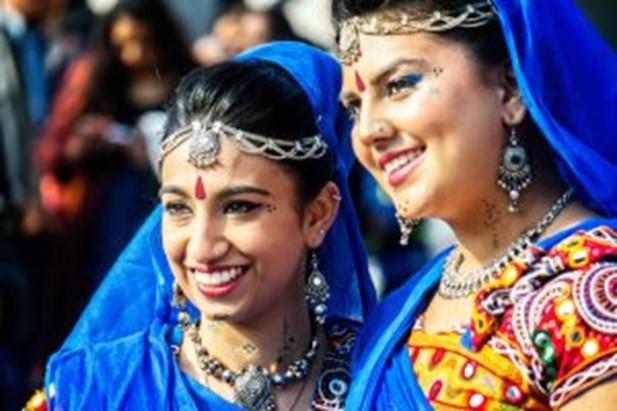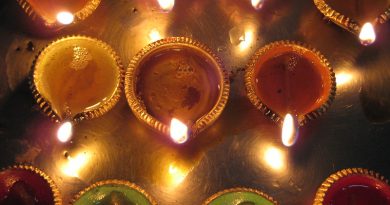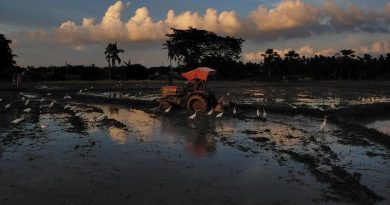The Indian Diaspora
The Indian diaspora is the largest in the world, numbering 31.2 million. It is widely dispersed throughout the world, with sizeable populations across each continent. The United States is home to the largest Indian population with 4.5 million, closely followed by Saudi Arabia with 4 million.
Other major populations include the United Arab Emirates with 2.8 million, Malaysia with 2.4 million, Pakistan with 2 million, the United Kingdom with 1.8 million, Canada with 1.5 million, South Africa with 1.2 million and Myanmar with 1 million. The population is so widespread due to two main factors, the size of the country itself and its history. Indian emigration can be divided into two main sections-colonial and post-colonial emigration. The various destinations of Indian settlement are divided across these two periods.
Much of the Indian diaspora throughout the Asian continent can trace its history back several centuries due to the regular shifting power dynamics across the region. While these communities have long since been deeply integrated into the respective countries, it is undeniable that Indians have historical presence in Southeast Asia, Arabia and Central Asia. A large number of the Indian diaspora can trace its history back to its time as a British colony, during which a large number of communities emerged throughout the world, mainly in other British colonies. This is especially the case for nearby former British colonies such as Pakistan, Bangladesh and Sri Lanka-as well as the United Kingdom itself.
Another factor to consider when taking into account large Indian populations in nearby countries such as these is that the modern-day borders were far more transient prior to their respective independence. Therefore, large numbers of Indians were living in countries such as Pakistan, Sri Lanka and Bangladesh prior to their takeover by the British and vice versa. These populations continue to exist today.
British colonial rule of India can account for a large portion of the modern-day diaspora, both directly and indirectly. During British rule of India, many subjects found themselves scattered across the globe to accommodate the demands of the ruling power across a number of other colonies. In addition to further increasing the communities in nearby British colonies such as Pakistan, Sri Lanka and Bangladesh, Indian subjects found themselves in territories such as Malaysia, Canada, South Africa, Australia, New Zealand and the United Kingdom. With the abolition of slavery in 1833, these initial settlers were often brought over as indentured labourers, naval officers or soldiers for various military incursions. The populations, in these cases, were initially relatively small and often transient, but sufficient enough to start small communities. The indentured labour system, known for its brutal mistreatment of subjects, was brought to an end in 1913. In total, this ‘old diaspora’ is believed to constitute 18 million people or 60% of the current total.
The ‘new diaspora’, as it is generally categorised, consists of post-World War Two immigration. This was facilitated by a number of major developments, most notably India’s independence from Britain in 1948. Its ties to Britain and the latter country’s high demand for unskilled and, at a later date, skilled workers, caused a major increase in Indian immigration to Britain. The previously small community exploded into one of the most significant Indian diaspora communities in the world. In addition, there were large patterns of immigration to other former colonies such as Canada, Australia, New Zealand and South Africa. The United States, now the most significant Indian diaspora population in the world, also emerged as a major destination as its previously strict immigration laws were relaxed considerably.
The most recent diaspora is often nicknamed the ‘Gulf Diaspora’ due to the region of emigration. During the 1970’s, the Arab Gulf exploded in terms of economic prosperity due to its wealth of oil reserves. Large numbers of Indian workers moved to various countries in this region such as Saudi Arabia, the United Arab Emirates, Oman, Kuwait and Qatar. The Arab Gulf States has emerged as an increasingly important destination for Indian workers over the last few decades and is home to one of the largest Indian diaspora populations on the planet.
Britain
The Indian diaspora community of the United Kingdom is the country’s most significant immigrant community and an essential part of its multicultural identity. Due to the length colonial ties between the two countries, Indian presence in Britain has existed since as early as the 18th Century. The Indian community is believed to comprise a total of 2.3% of the country’s total population.
The Indian community began to take root in the UK following its (often involuntary) resettlement by the East India Company. The earliest Indian immigrants were lascars, sailors recruited to replenish their crews. Domestic servants were also recruited and brought back to the United Kingdom. Eventually, the population diversified as students, diplomats and skilled workers settled in Britain over time. The population steadily grew and exploded in the aftermath of the Second World War and the disintegration of the British Empire. Many Indian workers seized the opportunity of the British Nationality Act of 1948, which facilitated travel among commonwealth countries.
The population is the most ubiquitous immigrant community in the country and widely dispersed throughout the country albeit with major bases in London (over 540,000), the West Midlands (185,000) and Southeast England (over 150,000).

Photos taken during the Diwali celebration at Trafalgar Square, Garry Knight, Flickr Creative Commons
By extension, the Indian populations of other former British colonies also experienced major surges in the wake of the British Empire’s dissolution. Canada and South Africa are the most notable examples. Canada’s Indian population has existed since the end of the 19th Century. The earliest settlers were Indian Army soldiers. The early Canadian settlers were predominantly Sikh and experienced considerable prejudice and oppression. They also dealt with immigration restrictions, similar to those imposed by countries such as the United States and Australia. This prevented the population from growing for much of the first half of the 20th Century.
The population exploded in the latter half of the 20th Century as India became an independent country and restrictions were eased in Canada. The community has since grown to be one of the country’s most affluent and successful demographics, with immigration remaining steady through the remainder of the 20th Century. The population is dispersed throughout the country but is most significant in the province of Ontario, (775,000) particularly in its biggest city Toronto. Other major population hubs include British Columbia (over 300,000) and its major city Vancouver as well as Alberta (175,000).
South Africa
South Africa’s Indian community has a unique history that is closely tied to the narrative of the British Empire. The community began as a group of indentured labourers dispatched to the country during its time as a British colony. The population is heavily centred in the city of Durban, which is considered to be largest ‘Indian’ city outside India. The population has dealt with considerable mistreatment throughout its history. From its beginnings as indentured servants through the Apartheid period, the Indian community has repeatedly struggled against adversity. In post-Apartheid South Africa, there have been a number of changes.

Hashim Amla, world famous former South African cricketer from Durban who is of Indian descent
Many Indians occupy positions of power throughout the social, political and economic spheres. The Indian impact on South African culture is best exemplified through its cuisine, with ‘bunny chow’ a symbol of cultural fusion between the two countries.
Malaysia
Malaysia is another country with a significant Indian population as a result of British colonialism. The country boasts a particularly large Tamil population, while the overall community exceeds 2 million. Despite this, the population’s presence in Malaysia significantly predates the formation fo the British Empire, with evidence of Indians in Malaysia being traced back to over 1700 years ago.
As the third largest ethnic population after Malays and Chinese, they represent a major part of the country’s cultural identity and are amongst the most affluent demographics in the country. There is also evidence of movement between the two countries’ during the time of Portuguese control. This increased considerably following the British colonial acquisition of territory throughout Asia. Sensing a major profit to be made in Malaysia’s plantations, there was a shortage of cheap labour, a vacancy imported Indian migrants were coerced into filling. The Indian population of Malaysia subsequently grew considerably during this period. By the beginning of the 1930’s, the Indian population numbered at over 640,000.
The growth of Indian emigration to Malaysia declined as the 20th Century progressed, but the population steadily increased as it became more and more deeply assimilated into the country’s culture. Indian influence on Malaysia’s notably diverse cuisine is evident with the high prevalence of curry dishes.
America
Despite this, the largest Indian diaspora population is, by some distance, the United States. Indian immigration to the United States can be traced back to the mid-19th Century, mainly in the West Coast. The community was predominantly Sikh. Indians, like many other Asian populations, had difficulty relocating to the US for much of the early 20th Century due to high restrictions on immigration.

Aziz Ansari is a comedian from South Carolina of Indian heritage. Walt Disney Television, Flickr Creative Commons
The population exploded following the implementation of the Immigration and Nationality Act of 1965, with the combination of the pre-existing Indian community and the wealth of economic opportunities making it an ideal destination. The community is spread out throughout the country.
Major hubs include Chicago, Washington, DC, Los Angeles, San Francisco, San Jose and Dallas. The New York Metropolitan Area is however the largest hub, by some distance with a population of over 525,000. New York City has a large Indian community but the real heart is in Jersey City, New Jersey, which is the most significant Indian enclave in the country. Despite the large population, the Indian population is not as ubiquitous as in other countries due to the sheer scale of the United States.
Arab Gulf States
The most recent wave of major Indian immigration is centred around the Arab Gulf States. Since the region’s rapid ascent to power in the 1970’s with the oil boom, it has been a major draw for immigration from around the world across a variety of social classes. Skilled workers make up a particularly large proportion of the Indian population in these countries. Arab Gulf states countries are well-known for their immigrant-dominant populations and grant citizenship to immigrants very quickly. So significant are the Indian communities in this region that they form a majority in countries such as Bahrain, Kuwait and Oman. They also represent a significant minority in countries such as Saudi Arabia and the United Arab Emirates.
As the largest diaspora population in the world, the Indian population’s story is difficult to condense into a cohesive narrative. What is clear however is that the already-diverse country, has achieved considerable success in a plethora of communities around the world and has overcome major bouts of adversity in doing so.
Main image: British Indians enjoying some traditional Bombay cafe fare at Dishoom London © Dishoom.




